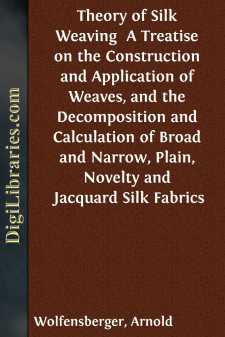Categories
- Antiques & Collectibles 13
- Architecture 36
- Art 48
- Bibles 22
- Biography & Autobiography 813
- Body, Mind & Spirit 142
- Business & Economics 28
- Children's Books 14
- Children's Fiction 11
- Computers 4
- Cooking 94
- Crafts & Hobbies 4
- Drama 346
- Education 46
- Family & Relationships 57
- Fiction 11829
- Games 19
- Gardening 17
- Health & Fitness 34
- History 1377
- House & Home 1
- Humor 147
- Juvenile Fiction 1873
- Juvenile Nonfiction 202
- Language Arts & Disciplines 88
- Law 16
- Literary Collections 686
- Literary Criticism 179
- Mathematics 13
- Medical 41
- Music 40
- Nature 179
- Non-Classifiable 1768
- Performing Arts 7
- Periodicals 1453
- Philosophy 64
- Photography 2
- Poetry 896
- Political Science 203
- Psychology 42
- Reference 154
- Religion 513
- Science 126
- Self-Help 84
- Social Science 81
- Sports & Recreation 34
- Study Aids 3
- Technology & Engineering 59
- Transportation 23
- Travel 463
- True Crime 29
Theory of Silk Weaving A Treatise on the Construction and Application of Weaves, and the Decomposition and Calculation of Broad and Narrow, Plain, Novelty and Jacquard Silk Fabrics
Categories:
Description:
Excerpt
PREFACE
The silk industry of America has of late years rapidly advanced to the front rank among the great textile industries of the world. It may indeed be proud of this position, to which that enterprising spirit and untiring energy peculiar to our nation, combined with our great technical and natural resources, has brought it.
That we are, on the other hand, not yet at the height of perfection we are also compelled to acknowledge, but if we consider the short space of time that the American industry has required for its development, as compared to the decades, almost centuries, to which some of the great European silk centers can look back, the fact is neither surprising nor discouraging.
While it must not be our aim to imitate or copy their ways, inasmuch as out conditions and circumstances are quite different from theirs, we may still profitably study their methods in order to overcome our deficiencies.
The greatest advantage which our competitors derive from such a long existence consists in having at their disposal a force of skilful, trained help. The manufacturers, appreciating the importance of this factor, make great efforts and pecuniary sacrifices to elevate and maintain the high standard of their industry.
For instance, they support textile schools and lecture courses, where young men can acquire a thorough technical education and equip themselves for a career of usefulness, thereby serving their own interests and at the same time furthering those of their chosen profession.
This beneficial influence cannot fail to exert itself from the standard of the higher employer down to that of the weaver, who would naturally take more pains and interest in his work than if he were a mere mechanical appendage to his loom in order to keep it in motion.
Very little has been done in his country for technical education as far as the silk industry is concerned, and it was on this special branch, that prompted the author to offer in the present little work a treatise on the theory of shaft weaving for broad silks and ribbons.
It is divided into three principal parts:
1st. Drawing-in the warp in the harness.
2nd. The weaves and their application.
3rd. Decomposition or analysis of the cloth.
To the foregoing there have been added in the revised and enlarged edition several additional parts covering the following: JACQUARD WEAVES, BOX LOOM WEAVES, including CREPES, and COST CALCULATIONS for plain and fancy weaves.
The subject while condensed, is made as clear and comprehensible as possible, and to many desirous of increasing their knowledge in this direction, this should prove a valuable help.
The author, through the medium of this work, hopes to win the approval and encouragement of the manufacturers, and will feel amply repaid should his efforts tend to develop a deeper interest in the "Queen of Textiles."
THEORY OF SILK WEAVING
With this term we designate the operation preceding the weaving, by which all the warp-threads are drawn through the heddles of the harness....


